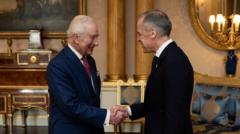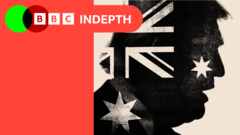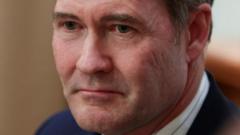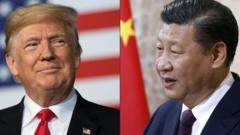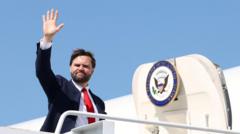As the Canadian election approaches, candidates are redefining their strategies amidst an explosive political climate, focusing on economic concerns and national identity.
Stunning Shift in Canadian Election Dynamics as Candidates Battle for Votes
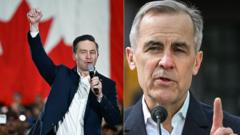
Stunning Shift in Canadian Election Dynamics as Candidates Battle for Votes
The political landscape sees a dramatic turn as new leadership emerges in the face of external pressures.
In the final hours leading to a pivotal election, Canada's political scene resembles a game of chess, with each move influenced significantly by external factors, primarily the enigmatic presence of former U.S. President Donald Trump. The Liberal leader, Mark Carney, has rallied crowds in Ontario, where spirited protests erupted in response to his warnings about the threats posed by the U.S. On the other hand, Conservative leader Pierre Poilievre is drawing enthusiastic crowds with calls for national pride in response to U.S. tariff threats.
With just days remaining in the election campaign, national polls indicate a tight race, illustrating a considerable shift in momentum. What was once a seemingly secure Conservative lead has dissolved with Carney's rise to prominence as the new Liberal leader following Justin Trudeau's resignation. Carney’s experience as a former central banker and his perceptive approach to current events are proving attractive to voters considering Trump's potential influences in Canada.
Evidence of discontent with the Liberal government was palpable, as many voters expressed concern over challenges such as a housing crisis. Eric and Carri Gionet, who attended a rally, voiced concerns for their children’s future housing opportunities. Meanwhile, the political atmosphere has shifted toward addressing these pressing concerns, with Poilievre emphasizing the failures of the previous Liberal administration.
The current climate has led to a surge of patriotism, framing the election as a referendum on national identity and economic stability. Carney's rhetoric reflects a model of stability against rising threats, a sentiment echoed by many who appreciate his promise to steer Canada through turbulent times. Conversely, Poilievre faces criticisms of aligning with Trump’s divisive strategies, necessitating a delicate balance to appeal to traditional Conservative values while addressing rising voter dissatisfaction.
As the campaign winds down, the stakes couldn't be higher, not only for the candidates but for the future of Canadian politics. Voters are urged to ponder the implications of their choices, as both frontrunners advocate for navigating a path forward amidst economic uncertainties, regional divides, and the overarching influence of U.S. policies.
While the major parties may dominate the election scene, the presence of smaller parties like the NDP, who have urged strategic voting, indicates that voter intentions could lead to unforeseen outcomes. In a reflection of changing dynamics, Carney's call for experienced leadership comes at a time when politicians grapple with escalating concerns regarding trade relations and internal socio-economic challenges.
As Canadians prepare to cast their votes, the election serves as a defining moment that may not only reshape party leadership but also redefine national direction against the backdrop of influence from south of the border.
With just days remaining in the election campaign, national polls indicate a tight race, illustrating a considerable shift in momentum. What was once a seemingly secure Conservative lead has dissolved with Carney's rise to prominence as the new Liberal leader following Justin Trudeau's resignation. Carney’s experience as a former central banker and his perceptive approach to current events are proving attractive to voters considering Trump's potential influences in Canada.
Evidence of discontent with the Liberal government was palpable, as many voters expressed concern over challenges such as a housing crisis. Eric and Carri Gionet, who attended a rally, voiced concerns for their children’s future housing opportunities. Meanwhile, the political atmosphere has shifted toward addressing these pressing concerns, with Poilievre emphasizing the failures of the previous Liberal administration.
The current climate has led to a surge of patriotism, framing the election as a referendum on national identity and economic stability. Carney's rhetoric reflects a model of stability against rising threats, a sentiment echoed by many who appreciate his promise to steer Canada through turbulent times. Conversely, Poilievre faces criticisms of aligning with Trump’s divisive strategies, necessitating a delicate balance to appeal to traditional Conservative values while addressing rising voter dissatisfaction.
As the campaign winds down, the stakes couldn't be higher, not only for the candidates but for the future of Canadian politics. Voters are urged to ponder the implications of their choices, as both frontrunners advocate for navigating a path forward amidst economic uncertainties, regional divides, and the overarching influence of U.S. policies.
While the major parties may dominate the election scene, the presence of smaller parties like the NDP, who have urged strategic voting, indicates that voter intentions could lead to unforeseen outcomes. In a reflection of changing dynamics, Carney's call for experienced leadership comes at a time when politicians grapple with escalating concerns regarding trade relations and internal socio-economic challenges.
As Canadians prepare to cast their votes, the election serves as a defining moment that may not only reshape party leadership but also redefine national direction against the backdrop of influence from south of the border.



